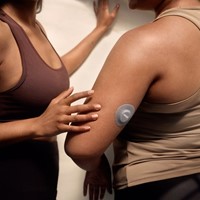Tweakments and non-invasive procedures like injectables are promoted as temporary and easily reversible, but the reality often brings a lot of complications
You could call it the Great Plastic Surgery Reversal of 2023. If it seemed like previously everyone in the public eye was getting cosmetic procedures, now it seems like they’re having them undone. The Kardashians have allegedly got rid of their BBLs; Love Islanders have had fillers dissolved; Blac Chyna has documented a drastic make-under; Courteney Cox expressed regret about getting overly injection-happy in the past and Kylie Jenner recently said she wished she had never touched her face. After almost a decade of lip filler dominating as a beauty trend, celebrities seem to be de-plumping in pursuit of a more “natural” look.
Experimenting with your facial and body features is now easier, cheaper and more accessible than ever before, and the global cosmetic surgery market is predicted to reach a staggering $71.93 billion by 2030. But just as the fashion world cycles through trends, so does the beauty world, and in recent years the pendulum has been swinging back towards a more “natural” look.
“There have been industry surveys done that show that people seeking aesthetic treatments are anxious about being judged for having them,” suggests Dr Paul Charlson of Skinfluencer London, a non-surgical aesthetic clinic. “The now-entrenched trend that is prevalent amongst younger patients – those in their twenties, for instance – for the overdone look such as bigger lips, bigger cheeks that have been led in part by reality TV stars and which you see all over Instagram, has become almost a caricature look.”
Part of the appeal of procedures like filler is that they are often billed as temporary or easily reversible and therefore lower stakes than cosmetic surgery. As these “non-invasive” treatments become more normalised and accessible, they are sometimes approached with the casualness of a beauty salon treatment rather than a medical procedure. However, dissolving filler – as well as correcting botched jobs – isn’t always so simple.
The most common dermal filler dissolving technique is injections of hyaluronidase, an enzyme that breaks down hyaluronic acid (this can only be done if they are hyaluronic acid fillers, as opposed to silicone, Sculptra or Radiesse). For many, this can work effectively. Lina, 32, from LA, chose to have the procedure after noticing her lip filler had migrated, creating what she calls a “shelf” above her lip. After having the dissolver administered with three sessions over six months – a process she admittedly describes as “painful, annoying and inconvenient” – it “ultimately worked, and we got back to square one”.
At the same time, there are reports emerging of dissolving procedures not going to plan. One community on Facebook, ‘Botched Fillers & Hyaluronidase Damage Support Group’, has almost 6,000 members, while another, ‘Botched Botox and Flawed Fillers’, has over 5,000. Many more exist. 32-year-old Taylor, from Chicago, is a member of the former group, and is keen to share her negative experience of getting hyaluronidase injected.
She describes attempting to correct some lumpy lip filler, which she then had dissolved to refill. Everything went smoothly the first time round, but after refilling, she noticed a nodule had formed on her lip. No problem, her injector said, they could just dissolve again and correct it. That time, she felt “immediate tingling all around my cheek and chin”, and two days later she woke up with “extreme burning and very clear, visible dents in my chin where I had experienced the pain,” she tells Dazed. “It was a horror film, to wake up every morning and feel extreme burning and not know what I'm going to see in the mirror”.
In the groups, members speak of feeling suicidal, of being unable to face life and having their confidence shattered. Many describe increased facial drooping, skin laxity and searing pain. Ella*, who is from London, describes having an “unusual reaction” to her lip injections, in that they made her skin chap and peel. After deciding to get the filler dissolved, she found that “right away they were wrinkled and smaller than they were before the filler”, which she’s confirmed by looking back at old photos – “so it’s not a case of me becoming ‘filler blind’”. “I have noticed that my lip border has also become blurred and not as defined as it once was,” she adds. “I am only 21, so seeing my lips so aged is horrible.”
“I feel very depressed,” she continues. “Knowing that I’ll never get my old lips back is heartbreaking, especially because when you get lip fillers done, you get reassured [by injectors] that if you don’t like the outcome you can always get them dissolved and they will look the same as before. In order to get rid of the lip wrinkles, I’m going to have to get them redone, which means I am now dependent on getting lip filler. One small decision that I made to get my lips filled has now ruined my life. I keep on looking back at my old pictures and wishing I just had my old lips back.”
An internet search reveals wildly conflicting information about whether fillers can stretch the skin or not. Dr Fazeela Abbasi, a dermatologist at Euromed Clinic Dubai, tells Dazed that they can if the injections are of poor quality or are poorly-placed. Love Island star Faye Winter is one celebrity who, along with the likes of Molly-Mae Hague, Olivia Hawkins and Shaughna Phillips, has been open about getting dissolver in pursuit of a more natural aesthetic. Winter, whose hyper-plumped lip look attracted criticism on the dating show, told This Morning how, after undergoing the dissolving process, she was left with “very wrinkly lips” since they had lost elasticity, and ended up putting 0.5ml back in them to smooth them out. Dr Abbasi adds that the longer someone has had filler, and the larger the volume injected, then the longer it is likely to take for lips to resume their previous appearance. “Generally, the longer the skin has been stretched, the more likely it will either need to be tightened or, in the case of lips, refilled gently with a smaller volume.”
It’s worth noting that celebrities have more money and influence at their disposal to tinker with various procedures. For ordinary people who don’t have unlimited cash, reversing procedures isn’t quite so straightforward, and some have found there is an even bigger price. “I’m consciously not trying to let it define my life, but it really did take over for a long while,” Taylor says. “It took away my self-esteem, made me feel ugly, made me feel like I would never feel beautiful again, like I couldn’t trust doctors. It’s just a really horrible experience.”
“People act like, ‘Oh I’ll get filler, because you know what, if I don’t like it, I’ll just get dissolver’ – no, dissolver should be a last resort” – Taylor
To make matters worse, Taylor says that when she approached the clinic about what happened, she was told she had “body dysmorphia” and was overreacting, despite photo evidence to the contrary, as well as her own accounts of pain. “That just drove me crazy because that’s just such a typical way to diminish my experience,” she says.
Unsurprisingly, given the industry is still largely unregulated, there are differing accounts of hyaluronidase’s impact, and some believe much more research needs to be carried out in the area. A small investigation cited in The Guardian found that around 20 per cent of 150 people reported adverse changes after having the enzyme injected. “I don’t have concerns about the safety of hyaluronidase, but rather about who and where it is being used,” says Dr Charlson. “In some instances, it is being used as a backstop for those offering filler treatments who do not have a medical background and they are using it to correct or dissolve work. This is not how it should be used. Rather, it should be prescribed by a doctor and administered in a medical facility.” He adds there is a one in 100 chance of an allergic reaction to it, so says prior patch tests are vital.
Dr Abbasi adds that if it has been more than three months and fillers have been injected in multiple areas around the face, she won’t dissolve them with hyaluronidase. “This is because the fillers have become intertwined with the collagen network in your skin so in essence, they have become part of the skin,” she says. “This is particularly worrying because they will be obstructing the lymphatic system, which will cause fluid retention, leading to bloating. Also, if you try to dissolve the filler once the three-month mark has passed, you will also be dissolving the natural collagen, elastin, which are the skin’s intrinsic fibres which will dramatically weaken the skin.” In those cases, she prefers to use a “heat-based fractionated laser or RF Microneedling to diffuse the filler out and allow the lymphatic drainage of fluids to become more efficient”.
But for people like Ella, who’ve had firsthand experience of injections, there’s an urgent need for research on how natural hyaluronic acid regenerates, thanks to unclear information she’s had from professionals. “I have contacted several clinics and some say it will regenerate within a few days after dissolving, some say within a few months, some say that it is impossible for dissolver to target your natural HA. There are such conflicting answers which, to me, makes it clear that no one knows for sure. That’s why people should be careful about going down the dermal filler journey.” Dr Naveen Somia, a Sydney surgeon, has called for greater regulation of dissolver, arguing that it is possible that hyaluronidase targets naturally-occurring hyaluronic acid in the face as well as the injected filler.
Taylor says she would warn people against “treat[ing] filler like a magic eraser. That’s what needs to change now. People act like, ‘Oh I’ll get filler, because you know what, if I don’t like it, I’ll just get dissolver’ – no, dissolver should be a last resort.” Another piece of advice, she adds, would be to “try not to just chase an outcome that’s just not going to happen and ruin yourself along the way. A lot of people assume that the bad outcomes aren’t going to happen to them, that it’s just an ‘other people’ thing. But the bad outcomes are just so much more common than people think.”
*Names have been changed
Join Dazed Club and be part of our world! You get exclusive access to events, parties, festivals and our editors, as well as a free subscription to Dazed for a year. Join for £5/month today.




